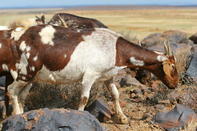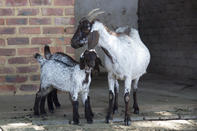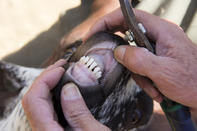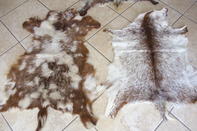Goats were among the first animals to be domesticated by man for the production of meat, milk, skins and fibre. Indigenous goats arrived in South Africa during the later part of the Stone Age with migrating tribes and are found in the areas where the different ethnic groups settled.

The general appearance of these goats support theories that they originated in different ecosystems. These various goat breeds include: Nguni Type Goats (Mbuzi) - small, multicoloured with semi-pendulous ears Eastern Cape Xhosa Lob Ear - multicoloured with large lob-ears Northern Cape Speckled - lob-eared and white body with red or black speckles Kunene Type (Kaokoland) - long thin legs, multicoloured and lob-eared.
The indigenous goat is also known as the 'Indigenous Veld Goat' (IVG) was officially registered as a breed in 2006 and a breeders' society was established. The indigenous goat is naturally bred for functional efficiency. They are antelope-like with long legs, so they move with ease and can walk long distances, to either graze or browse on a variety of plants.
They can either browse (±60%) or graze (±40%) on a wide variety of plants, shrubs and grasses, and have the potential to select for a higher quality diet over a short time, and can obtain nourishment from average forage quality. They have a relatively thick and generally good pigmented skin, with good pigment on the vulnerable parts (head, ears, muzzle, chest, back and lower legs), to protect them from the sun.
Advantages of Indigenous Goats

Research found indigenous goats are less susceptible to tick-borne diseases (like heartwater), more parasite tolerant and are generally more drought and disease resistant than meat or dairy goats. This reduces their maintenance costs. Most indigenous goats grow cashmere in winter, which is shed in the summer season.
Indigenous goats are highly fertile from a young age, have a long breeding season and produce offspring throughout the year. Indigenous goats produced much higher levels of milk fat and protein than Saanen goats, but milk production in indigenous goats is, however, very low. Their lactation periods are short, barely enough for their kids' needs.
This is in contrast to Saanen and Saanen x indigenous crossbred goats which produce sustained large amounts of milk over a 9 or 10-month lactation. Careful selection and breeding from the indigenous goats resulted in the three main meat goat breeds in South Africa - Boer goat, Kalahari Red goat, and Savannah goat.
Basic Statistics for Indigenous Goats

Indigenous goats have an average pregnancy of five months - around 150 days - and will give birth to a single or twin kids weighing about 2.5 kg.
The kids will be weaned at 12 - 15 kg. This is at 3 months to 3.5 months for male kids and 3.5 - 4 months for female kids, though some Eastern Cape farmers are weaning their kapaters (neutered males) at 5 months. A full-grown doe will Mbuzi type doe will weigh 35 - 40 kg. She will be ready for mating at 9 months of age.
A full-grown buck will weigh 45 - 50 kg. The weights of the males and females of the Xhosa Lob Ears and Northern Cape Speckled are ewes: 50kg – 60kg and rams: 70kg – 80kg. The optimal buck to doe ratio is 1 male goat for every 20 female goats. The main kidding seasons are April to June or September to December. An indigenous goat has an average lifespan of 10 - 12 years.
Indigenous Goat Products

Goat meat (chevon and cabrito) - is succulent with a good flavour and is low in cholesterol levels. Breeding stock - goats from heartwater areas (where this tick-borne disease is found) are resistant to this disease.
Heartwater is found in most of sub-Saharan Africa, but the disease is absent from the dry Kalahari Desert and dry coastal areas of Namibia and South Africa. Skins - can produce a variety of colour patterns for making ‘hair-on’ leather items. Quality leather - unblemished by tick bites.
Milk - used in many households and can be processed to other dairy products such as cheese. Cashmere - Cashmere is a fine hair produced during winter. Cashmere production is ideally suited in subsistence farming systems where farmers have close contact with their animals, knowing exactly when optimum shedding takes place and when to comb.
By Marinda Louw